Introduction
Jasper is a versatile and commonly encountered gemstone known for its abundant colours and intricate patterns. It is a variety of opaque chalcedony that often contains iron oxide, contributing to its wide spectrum of vibrant hues. The stone is sought after for its aesthetic appeal, grounding, and nurturing properties, making it a staple in crystal healing practices. Due to its unique beauty and significance, collectors and jewellers should consider making Jasper jewelry their next purchase, as it is truly a beautiful stone.
The stone comes in an impressive array of types, each with unique characteristics. Red Jasper, distinguished from other rocks by its deep red tones, is among the most prevalent types. In contrast, other varieties like Ocean Jasper, Picture Jasper, and Leopard Skin Jasper display a range of patterns and colour combinations. Each type of Jasper holds its own specific energies and attributions, contributing to the stone’s reputation as an incredibly multifaceted mineral.
Collectors and enthusiasts often seek Jasper for its distinct qualities and profound connection to the natural world. The stones’ appeal lies in their physical beauty and the sense of balance and tranquillity they are believed to impart. Each type of Jasper offers different hues and healing attributes, catering to a broad spectrum of tastes and therapeutic needs.
What is Jasper?
Jasper is a captivating gemstone that stands out for its unique patterns, vibrant colours, and remarkable durability. As a member of the quartz family, jasper is a microcrystalline variety of quartz (chalcedony), composed of microgranular quartz and/or cryptocrystalline chalcedony, along with other mineral phases. This composition gives Jasper its distinctive opaque quality and a rich palette of colours, typically ranging from red, yellow, and brown to green and occasionally blue. The stone’s intricate patterns and vibrant hues make it a popular choice for jewelry and decorative items, while its durability ensures it can withstand everyday wear and tear. Whether polished to a high shine or left in its natural state, Jasper’s beauty and versatility make it a cherished gemstone for collectors and artisans, making Jasper a valuable addition to any collection.
Historical Significance
Jasper has been esteemed throughout history. With ancient roots tracing back to early civilizations, jasper held significant cultural and spiritual value in societies such as Mesopotamia, Egypt, and among Native American tribes. Due to its beauty and presumed metaphysical properties, it was the gemstone of choice across various ancient cultures. Historically, jasper has been valued for its beauty and durability, being used for decorative and ceremonial purposes. Its enduring appeal is evident in the myriad of artifacts and historical references that underscore its significance across different eras and civilizations. Jasper derives from the word ‘spotted or speckled stone,’ highlighting its unique aesthetic and cultural heritage. Jasper’s historical significance and beauty make it a unique and valuable gemstone that collectors and jewellers should consider making Jasper their next purchase.
History and Etymology of Jasper
Jasper has a rich history that dates back thousands of years. The name “jasper” is derived from the Greek word “aspis,” meaning “spotted stone.” This term refers to the stone’s characteristic patterns and multicoloured appearance. Additionally, the word “jasper” comes from Old French, where it means “spotted or speckled stone,” further emphasizing its unique markings. Since ancient times, the term “jasper” has been used to describe a variety of stones that exhibit vibrant colours and unique markings.
In ancient Mesopotamia, both Red and Green Jasper were highly valued commodities. Around 7,000 years ago, Green Jasper was used in bow drills throughout the Indus Valley to carve other minerals like cornelian and semi-precious stones like lapis lazuli. Ancient people regarded Red Jasper as a sacred stone of physical and spiritual protection, a natural healing stone that symbolized courage and wisdom. Jasper and other gemstones are frequently mentioned in historical texts and religious artifacts, highlighting their symbolic and protective meanings.
In ancient Egypt, Red Jasper was linked to fertility and was named the fertilizing blood of Mother Isis. Red Jasper was sometimes placed around the neck of the deceased as an amulet carved with a scene from the 156th Chapter of the Book of the Dead.
In Ancient India, Jasper was appreciated for its intricate patterns and held a sacred place in art and architecture. It was used to create artistic ornaments and as an architectural accent in palaces and temples, showcasing its perceived sacredness. The Red Fort of Delhi, an iconic historical monument, features Jasper in its intricate inlay work, exemplifying its historical significance in Indian architecture.
Among Native American cultures, Jasper was considered a powerful protection stone often used in ceremonial rituals and as a healing stone. In North American Indian legends, Red Jasper was called the “blood of Mother Earth,” which stimulated health and rebirth. In European medieval lore, Jasper was believed to bring courage and relief from pain, making it a favoured stone among knights and warriors. Jasper’s significance is also documented in Latin literature, where its symbolic and protective qualities are noted in classical texts.
These historical uses highlight Jasper’s multifaceted significance, transcending mere aesthetic value. Its presence in various forms, from personal adornments to grand architectural designs, illustrates this gemstone’s deep-rooted and diverse appreciation across cultures and ages.
Jasper belongs to the chalcedony family. Learn about related stones in our Mineralogy Hub
Classifications of Jasper
Jasper is a versatile gemstone, available in various colours, patterns, and localities, which contributes to its popularity. Understanding its classifications is crucial for identifying and appreciating it.
By Colour
Jasper stones showcase a spectrum of colours due to various mineral impurities.
-
Red Jasper: This common jasper variety is a striking red stone, prized for its rich colour and aesthetic appeal due to iron(III) inclusions.
-
Yellow Jasper: Exhibits warm, sunny tones ranging from pale yellow to mustard.
-
Ocean Jasper: Known for its multi-coloured patterns with dominant greens, pinks, and whites.
-
Imperial Jasper: Features exquisite patterns, often in pastel shades.
-
Mookaite Jasper: An Australian jasper showing vibrant yellows, reds, and purples.
Due to its unique beauty and significance, collectors and jewellers should consider making Jasper their next purchase.

By Pattern
The patterns in Jasper are as diverse as its colours, with some varieties named for their distinctive appearances.
-
Banded Jasper: Displays stripes or bands of different colours or shades.
-
Orbicular Jasper (Ocean Jasper): Characterized by circular patterns or "orbs".
-
Poppy Jasper: Contains orb-like patterns reminiscent of poppy flowers.
-
Brecciated Jasper: Composed of broken fragments of Jasper that have naturally reformed, creating an abstract pattern.
-
Picture Jasper: Its patterns resemble landscapes, making each stone a natural piece of art.
By Origin
Jasper is found in various locations worldwide, with some varieties named after their geological source.
-
Biggs Jasper: Originates from Biggs Junction in Oregon, known for its detailed landscape-like patterns.
-
Mookaite Jasper: Sourced from Mooka Creek in Western Australia, valued for its rich colours.
-
Imperial Jasper: Found in Mexico, acclaimed for its fine and intricate patterns.
-
Ocean Jasper: Mined from the coastal areas of Madagascar, prized for its unique orbicular patterns and wide colour range. Ocean Jasper is named for the location of the original deposit in Madagascar, where it was discovered along the shoreline.
By dividing Jasper into these classifications, enthusiasts and collectors can better understand the stone's diversity and identify specific types more suited to their aesthetic or metaphysical preferences.
Explore dozens of Jasper types and more in our A–Z Gemstone Directory
Physical and Chemical Properties
Jasper is a distinctive gemstone renowned for its rich variety of colours and patterns. It is formed through the compaction and mineralization of silica-rich sediments or volcanic ash, which gives rise to its unique appearance. This section delves into the mineral composition and the attributes contributing to its hardness and durability.
Mineral Composition
Jasper is a stone fundamentally composed of microgranular quartz and cryptocrystalline chalcedony. These minerals give Jasper its opaque quality and contribute to its wide range of colours. Other mineral impurities within Jasper chiefly influence its colouration and patterning, leading to the numerous types of Jasper found globally. Iron oxides, such as hematite and goethite, are responsible for many of Jasper's distinctive red and brown colours.
Hardness and Durability
Jasper is known for its impressive hardness and durability. It ranks around 6.5 to 7 on the Mohs hardness scale, which measures a mineral's resistance to scratching. This hardness is derived from its quartz content, making it suitable for various jewellery and ornamental applications. Its opaque nature and resistance to weathering also make it an ideal material for architectural features. Jasper's durability is further enhanced by its chemical stability, which helps maintain its integrity over time against natural elements.
Colour Variations of Jasper
Jasper's wide palette of colours and intricate patterns make it a distinct and versatile gemstone. Each variation's unique aesthetic appeal is attributed to its specific composition and locality.
Red and Yellow Jasper
Red Jasper typically exhibits hues ranging from deep rust red to bright scarlet, owed largely to its iron oxide content. The stone’s red tone may vary from opaque to translucent, making each specimen distinctive. Red Jasper is also believed to help alleviate stress and promote emotional stability, thanks to its grounding and calming properties. Yellow Jasper, however, presents colours from mustard to golden, often containing subtle bands or mottled patterns, adding to its visual interest.
Green and Blue Jasper
Jasper's Green varieties display shades from light olive to dark forest green. Minerals like iron silicate or chlorite give the stone its verdant hues. Blue Jasper is less common. It occurs in tones from sky blue to navy, incorporating flecks of black or patterns of cream, enhancing its rarity and desirability.
Multicoloured and Patterned Jasper
Jasper stone is renowned for its multicoloured specimens, which boast an array of hues and patterns. These stones can combine any combination of the abovementioned colours, intermingled with black, white, or brown. Their unique colour patterns and habits, including banding and spotted stone designs, result from mineral impurities and geological processes. Jasper bearing landscape-like patterns is especially sought for its artistic and natural aesthetic.
Symbolism and Healing Properties of Jasper Colours
Each colour of Jasper carries its own symbolism and is believed to possess specific healing properties, making this gemstone visually appealing and spiritually significant.
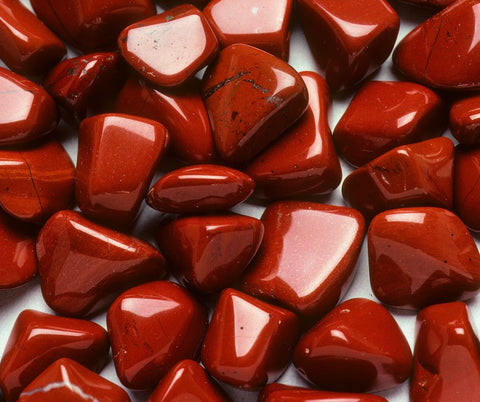
-
Red Jasper: Often associated with strength, vitality, and courage, Red Jasper is believed to promote grounding and stability. It’s also thought to enhance endurance and stamina, making it a popular choice for athletes and those facing physical challenges. Red jasper is linked to the root chakra, while green jasper connects to the heart chakra. Due to its unique beauty and significance, collectors and jewellers should consider making jasper their next purchase.

-
Yellow Jasper symbolizes optimism and joy. It is said to help channel positive energy and stimulate the solar plexus chakra, enhancing self-confidence and personal power.

-
Green Jasper: Known for its nurturing properties, Green Jasper is associated with balance and harmony. It’s believed to help heal and soothe emotional distress and is often used in practices that foster emotional recovery.
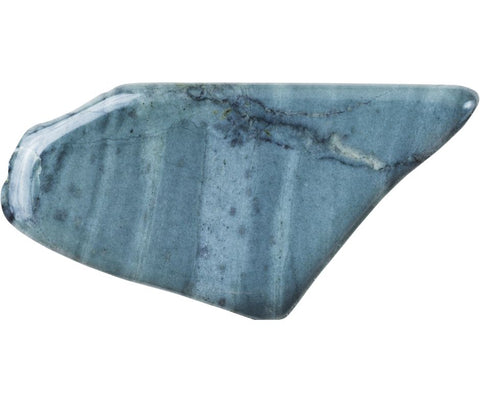
-
Blue Jasper: Blue Jasper is linked with calmness and tranquillity. It is thought to aid in communication, promoting clarity of thought and articulate expression. This makes it a favourite stone for public speakers and those seeking to improve their communication skills.
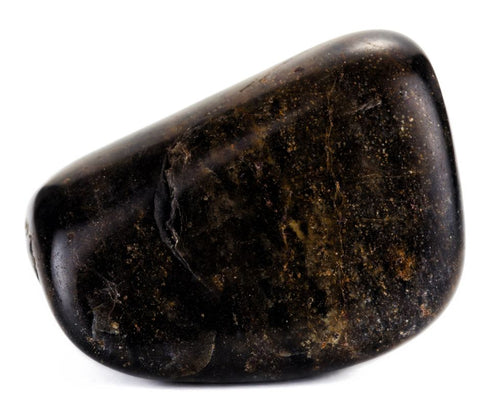
- Black Jasper: As a protective stone, Black Jasper is believed to provide a strong shield against negative energies. It’s often used in grounding rituals and is thought to promote deep insight and inner stability.
- Multicoloured Jasper: These stones, with their blend of colours, are said to combine the properties of the included hues. They are often used for overall healing and balance, bringing together the diverse energies of their constituent colours.
These symbolic associations and healing properties contribute to Jasper’s popularity in various therapeutic and spiritual practices. Whether used for meditation, crystal healing, or simply as a comforting presence, Jasper’s different colours offer a wide range of possibilities for enhancing emotional and spiritual well-being.
Jasper in Geology
The geology of Jasper encompasses its complex formation process and geographical distribution, where distinct conditions lead to a variety of types specific to certain regions.
Formation Process and Volcanic Ash
Jasper forms through the sedimentary process or volcanic activity, where silica-rich sediment or volcanic ash consolidates into rock. Jasper forms when loose sediments become cemented together by silica-rich groundwater. Key factors include the presence of iron impurities in volcanic rock, which give Jasper its distinctive red colour. Over time, this silica sediment or ash is cemented with other mineral deposits, creating a dense, opaque form of chalcedony.
Locales and Sources
Geologically, Jasper is sourced from various regions:
-
Oregon: Known for its unique Ocean Jasper, sourced from the state's coastal areas.
-
Madagascar: Supplies elaborate patterns of Ocean Jasper.
-
Indonesia: Hosts volcanic regions that contribute to Jasper formation.
-
Russia: Offers varieties such as Picture Jasper, which often depicts scenic patterns reminiscent of landscapes.
-
Australia: Renowned for Mookaite Jasper, sourced from Western Australia, characterized by its bold colours.
-
Kazakhstan: Provides unique landscape-patterned varieties.
-
United States: Besides Oregon, Jasper deposits are found in other states, each with its unique blend of Jasper types.
These regions illustrate the diverse environments in which Jasper can form, from sedimentary contexts like riverbeds and shorelines to the remnants of volcanic eruptions. Each locale imparts a signature touch to the Jasper found there, influenced by the area's specific geological makeup and historical geologic events.
Where is Jasper Found?
Jasper is found worldwide, with notable deposits in Brazil, India, Madagascar, Russia, the United States (particularly Oregon, Idaho, and Arizona), and Australia. It is a relatively common stone found in various geological settings, including sedimentary rocks, volcanic ash, and hydrothermal veins.
Jasper is often associated with other minerals, such as quartz, chalcedony, and hematite, which can create a range of colours and patterns. The stone’s formation is often the result of the compaction and mineralization of sediment or volcanic ash over time.
Some of the most notable types of jasper include Picture Jasper, known for its scenic patterns resembling landscapes or natural scenes, and Ocean Jasper, recognized by its unique swirls and orb-like patterns. Other popular varieties include Red Jasper, Green Jasper, Yellow Jasper, and Dalmatian Jasper, each with exceptional characteristics and properties.
Understanding Jasper's diverse origins and geological settings can help enthusiasts and collectors better appreciate the stone’s beauty and significance. Whether found in the sedimentary layers of ancient riverbeds or the remnants of volcanic activity, each piece of jasper tells a unique story of the Earth’s geological history.
Common Types of Jasper
The Jasper family showcases a diverse array of patterns and colours. Each type brings its unique aesthetic and is often associated with specific metaphysical properties. This section provides insights into commonly encountered Jasper varieties.
Jasper's remarkable diversity makes it a valuable addition to any collection of gemstones.
Common Jasper Varieties
Red Jasper: Characterized by its vibrant, deep red to brownish-red hue, often with streaks of iron oxide.
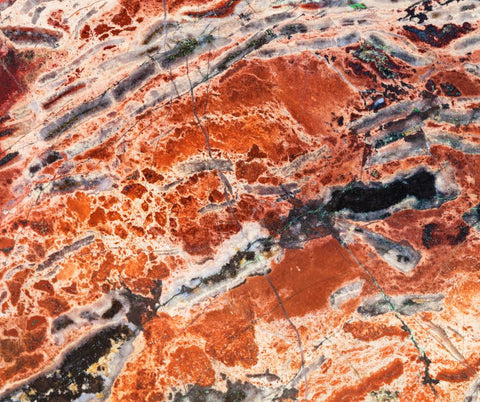
- Brecciated Jasper: Offering a mosaic of red tones interlaced with dark or light angular fragments, this Jasper promotes emotional stability and mental clarity.

- Zebra Jasper: With its signature alternating bands of black and white, Zebra Jasper is a grounding stone believed to foster physical energy and optimism over negative energy.
- Fancy Jasper: This multicoloured stone, which can be green, lilac, pink, or red, is celebrated for its comforting and repairing qualities.
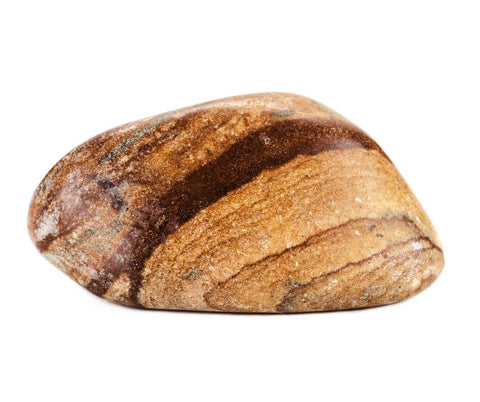
- Picture Jasper: It reveals nature-like, scenic patterns with rich brown, tan, and creamy hues. It is often used for nurturing and protection.
- Picasso Jasper: This variety displays striking abstract lines and patterns reminiscent of Picasso's paintings and is considered inspiring for creative minds.
Rare Types of Jasper
Jasper is a versatile gemstone with various patterns and colours. Each type has a distinct geography and rarity. Some jasper types are rare due to their unique appearance and the conditions required for their formation.
Unique Varieties and Their Origins
-
Kaleidoscope Jasper:
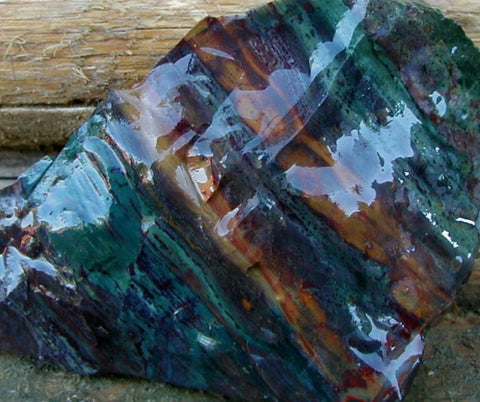
- Found only in Oregon, USA, this jasper is named for its vibrant, multi-coloured patterns that resemble a kaleidoscope.
- Poppy Jasper: Typically hailing from California, USA, this stone is characterized by orbicular patterns reminiscent of poppy flowers.
- Spiderweb Jasper: A rare type distinguished by its web-like patterns, originating from several locations, including Madagascar.
- Cherry Creek Jasper:

- Discovered in Mainland China, it's prized for its interlaced red, green, and yellow colours, which resemble creek waters.
-
Dragon Blood Jasper: An uncommon variety from Western Australia featuring a combination of green epidote and red piemontite.
-
Ocean Wave Jasper: A scarce type that was mined off the northwest coast of Madagascar and is celebrated for its oceanic patterns.
-
Silver Leaf Jasper: This jasper occurs mainly in Africa and is known for its silvery, leaf-like patterning.
-
Sunset Jasper: Found in Madagascar, it offers vibrant reds and oranges, mimicking the colours of a sunset.
-
Wild Horse Jasper: This species, predominantly found in southeastern Oregon, has a striking brown and white pattern akin to the coat of a wild horse.
-
African Jasper: This term refers to jasper found across the African continent, admired for its earthen colours and varied patterns.
-
Biggs Jasper:

-
Sourced from Biggs Junction in Oregon, it is famous for its beautiful blue-grey to brown landscape-like patterns.
-
Cappuccino Jasper: Comes primarily from Madagascar, sporting patterns resembling a cappuccino's frothy mix.
-
Deschutes Jasper, Known for its fine grain, is a stone from the Deschutes River in Oregon. Its colours resemble those of the river's canyon.
-
Elephant Skin Jasper is unique for its grey and brown, wrinkled, elephant-skin-like patterns. It is primarily from Africa.
-
Holly Blue Jasper is a rare blue jasper found in Oregon, USA, and is named for its holly-like blue hue.
-
Indian Blanket Jasper: This jasper, sourced from India, is treasured for its blanket-like patterns of red, white, and black.
-
Landscape Jasper: appropriately named for its scenic, landscape-like patterns, is typically found in multiple locations, including Madagascar.
-
Morgan Hill Jasper: Extracted near Morgan Hill, California, recognized by its red and green patterned appearance.
-
Orbicular Jasper:
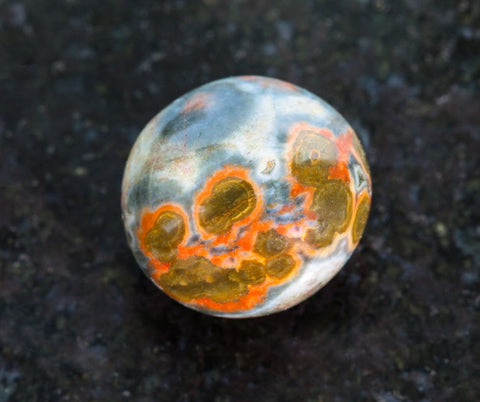
Also known as Ocean Jasper, this variety has orb-like patterns and is mainly sourced from Madagascar. Fierce Lynx Recommends: Autumn by the Ocean - Ocean Jasper Bracelet
- Polychrome Jasper:

Discovered in Madagascar, it displays multiple colours and is sought after for its vibrant and earthy tones.
- Leopard Skin Jasper:

-
This jasper, found in Mexico, is named for its leopard skin-like spots and is also referred to as Jaguar Stone.
-
Skin Jasper: Originates from Australia and features a unique pattern resembling a snake's skin.
-
Starry Night Jasper: This rare type, sourced in Oregon, is notable for its dark base and spots that sparkle like stars.
-
Texas Plume Jasper: Hails from Texas in the US and is known for its plume-like formations within the stone.
-
Willow Creek Jasper: This jasper is exclusive to Idaho, USA. It's renowned for its fine grain and is considered the finest porcelain jasper due to its pastel colours.
-
Bruneau Jasper:

Known for its captivating circular patterns and deep brown and red hues, Bruneau Jasper is a sought-after variety from the Bruneau River in Idaho. It's prized for its unique, orb-like formations that create stunning, eye-catching designs.
Morrisonite Jasper:
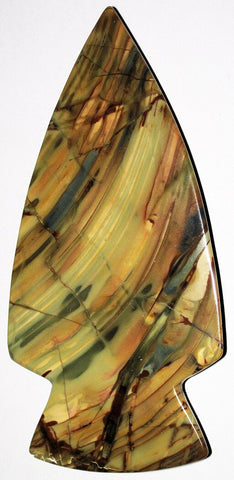
-
It is often called the “King of Jaspers” for its exceptional quality and vibrant, multi-coloured patterns. Found in the Morrison area of Oregon, it's celebrated for its intricate landscape-like scenes and smooth, polished finish.
-
Brown Jasper: A grounding and stabilizing stone, Brown Jasper exhibits earthy tones ranging from deep chocolate to light tan. Its soothing colour palette makes it a popular choice for jewelry that exudes natural, understated elegance.
-
Rainbow Jasper: True to its name, Rainbow Jasper displays a spectrum of colours, often in banded patterns. Each piece is a natural kaleidoscope, reflecting a harmonious blend of red, green, yellow, and sometimes blue hues.
-
Honey Jasper: This variety is known for its nurturing energy. It exhibits warm, golden tones reminiscent of honey. Honey Jasper often features subtle banding or swirling patterns, adding to its visual appeal.
-
Turquoise Jasper: This rare variety, a unique blend of Jasper and turquoise hues, stands out for its striking blue-green coloration. It's often sought after for its refreshing and vibrant appearance.
-
Genesis Jasper: This type is characterized by abstract, often geometric patterns. Its palette typically includes a mix of earthy tones, making each piece distinct and visually captivating.
-
Confetti Jasper: As festive as its name suggests, Confetti Jasper is dotted with multi-coloured spots against a lighter background, resembling a burst of confetti. It's a playful and vibrant variety that adds a pop of colour to any collection.
-
Noreena Jasper: This product hails from the Pilbara region of Western Australia and is known for its striking red and yellow patterns. Its fiery, angular designs resemble a desert landscape, creating a dramatic and eye-catching variety.
-
Red Creek Jasper: Named after the creek where it was first found, this Jasper variety is admired for its scenic patterns in shades of red, green, and tan. It often resembles a painted landscape, making each piece a natural work of art.
-
Porcelain Jasper (Exotica, Santefe, and SciFi Jasper) is renowned for its smooth, porcelain-like finish and striking patterns. This versatile stone is often used in high-end jewelry and is available in various colours, from soft pastels to bold hues.
-
Imperial Jasper:
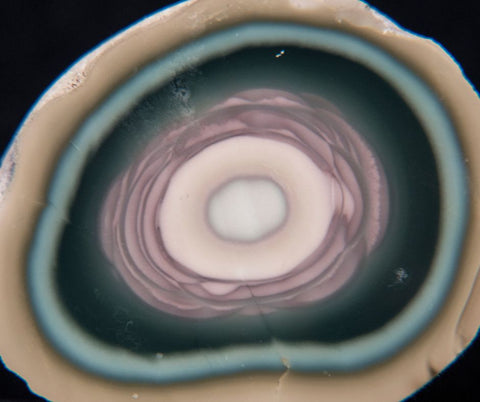
-
Renowned for its intricate patterns and vibrant hues, this highly valued variety is found in Mexico and is often used in high-end jewelry for its elegance and translucency. Believed to promote tranquillity and healing, it's sought after for its aesthetic appeal and metaphysical properties, making it a prized gemstone among collectors and enthusiasts.
-
Basanite Jasper (aka Black Jasper) is a protective and grounding stone. It is deep black with occasional streaks of other colours. It's known for its solid, dense texture and is often used as a touchstone or in protective amulets.
-
Fossil Jasper: This variety incorporates ancient fossils within its structure, making each piece a fragment of history. The patterns created by these fossils are unique, offering a tangible connection to the past.
-
Green Hair Jasper: This jasper variety is both rare and intriguing. It is characterized by its green colour with hair-like inclusions. The delicate, thread-like patterns offer a unique aesthetic reminiscent of a green, mossy landscape.
-
Chrysanthemum Jasper: Named for its flower-like patterns resembling chrysanthemums, this Jasper blends floral beauty and mineral wonder. Its patterns are often in contrasting colours, making it a visually striking choice.
-
Plum Jasper (aka Plum Blossom Jasper): This variety features patterns that resemble plum blossoms, with soft pinks and purples set against a darker background. It symbolizes beauty and resemblance to its namesake. It symbolizes beauty and renewal.
-
Royal Plume Jasper or Purple Jasper: This rare variety exudes elegance and sophistication. It is known for its majestic purple hues and feather-like patterns, which add a regal touch to any collection.
-
Maligano Jasper: Originating from Indonesia, Maligano Jasper is celebrated for its abstract and scenic patterns, often resembling landscapes or underwater scenes. Its diverse colour palette includes grays, yellows, oranges, and reds.
-
Kona Jasper: This Hawaiian variety is as warm and inviting as the island named after. It typically features a blend of earthy reds and browns, interspersed with occasional greens and yellows reminiscent of volcanic landscapes.
Identifying and Authenticating Jasper
Identifying and authenticating Jasper can be fascinating yet challenging due to its various colours and patterns. One of the most distinctive features of jasper is its opaque appearance, which sets it apart from other types of chalcedony. Unlike translucent stones, jasper does not allow light to pass through, making its vibrant colours and intricate patterns even more striking. These patterns can include swirls, bands, or speckles, often in red, green, yellow, and brown hues.
To authenticate Jasper, it’s essential to examine its hardness and density. Jasper ranks 6.5 and 7 on the Mohs hardness scale, indicating its resistance to scratching. Additionally, it has a density of 2.5 to 2.9 g/cm3, which can be measured using specific gravity tests. By looking for these characteristic patterns, colours, and physical properties, you can confidently identify genuine jasper stones and appreciate their unique beauty.
Caring for Jasper
Thanks to its durability, caring for jasper is relatively straightforward. However, follow a few simple guidelines to keep your Jasper stones looking their best. Regular cleaning is essential to maintaining their vibrant appearance. Jasper can be polished using a rock tumbler or by hand with progressively finer-grit sandpapers, followed by a polishing compound. To clean jasper, rinse the stone under running water and gently dry it with a soft cloth. Avoid using ultrasonic cleaners or harsh chemicals, which can damage the stone’s surface.
It’s also crucial to protect Jasper from extreme temperatures and prolonged exposure to direct sunlight, which can cause the stone to fade or become discoloured. Store your Jasper jewelry and decorative items in a cool, dry place away from harsh environmental conditions. By following these care tips, you can ensure that your Jasper stones remain beautiful and vibrant for years to come.
See Jasper featured in our Harvest Lynx Bracelet Set and Flameborn Dragon Bracelet
Choosing the Right Jasper Stone
Choosing the right Jasper stone can be an exciting journey, given the variety of colours, patterns, and metaphysical properties available. Here are a few factors to consider when selecting a Jasper stone:
-
Colour: Jasper comes in a stunning array of colours, including red, green, yellow, brown, and blue. Think about which colour resonates with you and complements your intended use, whether for jewelry or decorative purposes.
-
Pattern: Jasper is renowned for its unique patterns, ranging from simple bands to intricate swirls and speckles. Consider what type of pattern appeals to you and fits your design vision.
-
Hardness: With a Mohs hardness of 6.5 to 7, jasper is a durable stone suitable for everyday wear. Ensure the stone’s hardness aligns with your intended use, especially for jewelry.
-
Meaning: Jasper is often associated with various healing properties and is linked to the root chakra. Reflect on the type of energy you want to attract and the stone’s metaphysical attributes.
Some popular types of jasper include:
-
Green Jasper: Known for its calming and balancing energy, it promotes emotional stability and well-being.
-
Picture Jasper: This gemstone features intricate patterns that resemble landscapes or natural scenes. It is believed to foster a deep connection to the Earth and offer grounding and nurturing energy.
-
Red Jasper is celebrated for its energizing and stimulating properties. It is thought to enhance physical strength, vitality, and emotional stability.
-
Ocean Jasper: Due to its unique orb-like patterns, it is often called the “Atlantis Stone. " It is said to promote calming and soothing energy.
Ultimately, the right Jasper stone depends on your preferences and needs. Consider the type of energy you wish to attract, the design you want to create, and the stone’s specific properties to find the perfect jasper for your collection.
Commonly Mistaken for Jasper
While jasper is a well-known gemstone, several other minerals and stones are often misidentified as jasper gemstones. Jasper has historically been used to create decorative items such as vases, seals, and snuff boxes, valued for its beauty and craftsmanship. It’s important to distinguish authentic jasper varieties from those resembling them.
-
Dalmatian Jasper:

Despite its name, Dalmatian Jasper is not true jasper. More accurately, it is a variety of igneous rock that contains black or brown spots of arfvedsonite, which create a pattern reminiscent of the Dalmatian dog breed.
Rainforest Jasper:

Also known as Green Rhyolite, Rainforest Jasper is often mistaken for jasper due to its green and brown earthy colours and orbicular patterns. However, this stone is rhyolite and gets its distinctive appearance from the volcanic activity where it forms.
Bumblebee Jasper:

Bumblebee Jasper’s striking yellow, orange, and black banding makes it easily misinterpreted as jasper. In reality, it is a fibrous calcite with bands of volcanic lava. Bumblebee Jasper contains sulphur and arsenic, substances not found in genuine jasper stones. Fierce Lynx Recommends: Honey Bee Fierce - Bumblebee Jasper Bracelet
Crocodile Jasper:

Similarly mislabelled, Crocodile Jasper, also known as Kambaba Jasper, is not true jasper but a sedimentary rock of fossilized algae. Its patterns do resemble those of crocodile skin, inspiring its name. Fierce Lynx Recommends: Visionary Lynx - Green Jasper & Spinel Bracelet Set
Unakite:
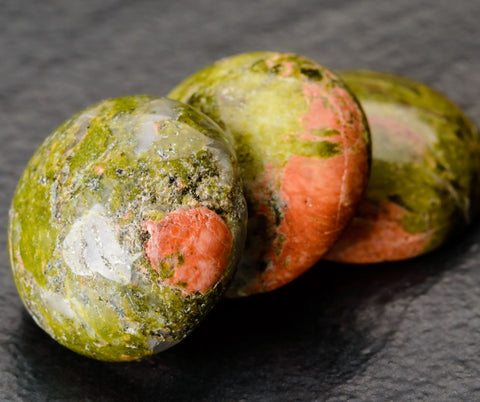
Often mistaken for Jasper due to its similar appearance and the presence of green and pink colours that are also common in certain Jasper varieties. Unakite is a granite type, an igneous rock composed primarily of green epidote, pink orthoclase feldspar, and clear quartz. This combination gives Unakite its unique mottled appearance, blending green, pink, and sometimes white or grey hues. Feldspar, which is not found in Jasper, is a key differentiator.
These stones each have distinct properties and origins, setting them apart from jasper, which is typically a form of chalcedony characterized by its opaque appearance and high silica content. Identifying these stones correctly is critical for gem collectors and enthusiasts to appreciate and value their collections accurately.
Jasper in Jewelry
Jasper’s remarkable diversity of patterns and colours makes it a favourite among jewelry designers and gemstone enthusiasts alike. Jasper offers endless possibilities for creative expression with hues ranging from earthy browns and vibrant reds to lush greens, sunny yellows, and even rare blues. Its durability—ranking 6.5 to 7 on the Mohs scale—ensures that jasper gemstones can be crafted into rings, pendants, earrings, and bracelets that stand up to everyday wear. Whether set in gold, silver, or paired with other gemstones, jasper’s unique forms and intricate patterns make each piece of jewelry truly one-of-a-kind.
Popular Uses and Styles
Jasper’s natural beauty shines in statement jewelry, where its diverse patterns and bold colours can take center stage. Red jasper, with its deep, rich colour, is especially prized for rings and pendants that exude warmth and vitality. Green jasper is often chosen for its calming presence and is popular in modern and bohemian-inspired designs. Ocean jasper, with its swirling, orb-like patterns, creates eye-catching pieces that evoke the beauty of the sea. Poppy Jasper, known for its vibrant, flower-like spots, adds a playful touch to earrings and bracelets. With its landscape-like images, Picture Jasper is frequently used in rings and pendants, allowing wearers to carry a miniature work of art. Each jasper variety brings its unique charm, making it easy to find a piece that reflects your personal style and appreciation for natural beauty.
Care Tips for Jasper Jewelry
A little care goes a long way to keep your Jasper jewelry looking its best. Avoid exposing Jasper to harsh chemicals, ultrasonic cleaners, or extreme temperatures, as these can dull its surface or cause damage. Clean your jasper pieces gently with a soft cloth and a mild soap solution, then dry thoroughly to prevent water spots. Store Jasper jewelry separately from harder gemstones and metals to preserve the stone's beauty to avoid scratches. Remove Jasper rings and bracelets before engaging in activities that could cause impact or abrasion. With these simple care tips, your Jasper jewelry will maintain its vibrant colours and natural allure for years to come.
Jasper and Chakras
Jasper is celebrated for its visual appeal, its reputed healing properties, and its role in energy work. Many believe that jasper stones can promote emotional stability, physical strength, and spiritual growth, making them a popular choice for those seeking balance and well-being. Whether used in meditation, worn as jewelry, or placed in a living space, jasper is valued for its grounding and nurturing properties.
Jasper’s Role in Chakra Balancing
Jasper is most commonly associated with the root chakra, the energy center linked to feelings of safety, security, and grounding. Red jasper, in particular, is believed to stimulate the root chakra, encouraging courage, confidence, and emotional balance. This makes it a favoured stone for those seeking to enhance their sense of stability and resilience. On the other hand, Green jasper is connected to the heart chakra, which is thought to promote emotional healing, compassion, and empathy. By wearing or meditating with jasper, individuals can tap into the stone’s healing properties, supporting both physical strength and emotional stability. Whether you’re drawn to Jasper for its beauty or its metaphysical properties, incorporating this stone into your energy practices can help foster balance, harmony, and a deeper connection to yourself and the world around you.
Frequently Asked Questions
This section addresses key queries about Jasper and illuminates its types, value, identification, historical references, and defining characteristics.
How many kinds of Jasper are there?
Numerous varieties of Jasper exist, each with unique colour patterns and formations. Over a dozen recognized types of Jasper are reported, not including regional variants and lesser-known forms.
What are the most valuable varieties of Jasper?
Value in Jasper stones is often subjective and based on aesthetic appeal. However, varieties like Imperial Jasper and Ocean Jasper are highly valuable due to their rarity and distinctive patterns.
How does one identify genuine Jasper stones?
Genuine Jasper is identifiable by its opacity and grainy, impure texture. Its hardness is about 6.5 to 7 on the Mohs scale. Experts can also perform specific tests to confirm its authenticity.
How is Jasper referenced within biblical texts?
Jasper is mentioned in biblical literature, notably in the Book of Revelation, as one of the stones found in the walls of the New Jerusalem. It symbolizes clarity,, spiritual wisdom, and truth.
Is Jasper a stone or a crystal?
Jasper is a stone, specifically an opaque, impure chalcedony, a form of microcrystalline quartz.
What colour is pure Jasper?
Pure Jasper is typically red due to iron inclusions. However, depending on its minerals and impurities, it can also be bright yellow, green, blue, or brown.









